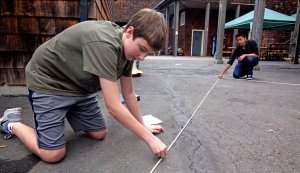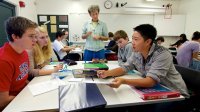How Collaborative Learning Leads to Student Success
Encouraging students to reach out to each other to solve problems and share knowledge not only builds collaboration skills, it leads to deeper learning and understanding at The College Preparatory School in Oakland, California.
It's a foggy, grey morning in Oakland, California, but that hasn't deterred Betsy Thomas, a math teacher at The College Preparatory School (College Prep), from taking her students outside for a geometry lesson. Today, her students will become land surveyors, using rope and chalk to draw geometric shapes on the courtyard's blacktop. Her aims are to help students visualize the concepts already introduced in the classroom and to reinforce the learning through group collaboration. The assignment requires teamwork, communication, and precision.
A team of three boys begins constructing an equilateral triangle, after which they will construct two parallel lines and a triangle circumscribed by a circle. One student holds the rope in place at one vertex of the triangle, while the other two slowly move in a circle, using the rope as a giant compass to mark out the other points of the triangle. "Excellent work, fellas," Thomas says, nodding her approval.

College Prep is an elite, coed, nonprofit private high school, tucked into a scenic glen in the foothills of Oakland, California. The school enrolls students from almost 80 different schools in the San Francisco Bay Area. Tuition is about $34,000 per student and roughly 25 percent of students receive financial aid or scholarships. None have special needs or require English-language-learner services; 100 percent are admitted to college, most to top-tier universities.
It's obvious that the school possesses opportunities and resources beyond the dreams of the majority of America's schools. And yet, when you look at the learning strategies the school embraces and you ask the faculty and students what has made the most positive difference for them, what you see and hear are not freighted with dollar signs. What you see and hear are the age-old power and impact of collaborative learning, where three boys, sharing strings and chalk, are bent over the blacktop surveying triangles, as the father of geometry, Euclid, might have directed them to do more than 2,000 years ago.
The Sights and Sounds of Peer-to-Peer, Student-Led Learning
On any given day at College Prep, you will likely see quartets of students unraveling problem sets in math class (PDF) and hear the buzz of them asking questions and explaining things to each other; in English classes, you may see the teacher silently observing from the corner of the classroom while her students lead their own discussion about the book they are reading. Outside class, the peer-to-peer learning continues as students huddle around laptops and textbooks during breaks in the courtyard or in The Learning Center.
"What our collaborative learning style empowers and enables is a student's resilience -- how do you look to your neighbor as a resource, how do you test your own theories, how do you understand if you're on the right track or the wrong track?" says Monique DeVane, College Prep's head of school. "It teaches them that it's not just about content; it's about cultivating habits of mind that are the underpinnings of deeper scholarship."
Teachers at College Prep have strategies that facilitate this style of learning and promote a sense of shared responsibility among the students. In math, for instance, the teachers prompt the students to ask each other their questions before asking the teacher, so that students learn to rely on their own collective wisdom. The daily class worksheets (PDF) and periodic group tests (PDF) are intentionally designed to be harder than the individual homework or exams, and students quickly come to recognize how they are able to solve things as a group that they might not have been able to on their own. "I like the group tests because there are more challenging questions," one student explains, "and if I were doing them by myself, I probably wouldn't get them. But when you have three other people to help, then we figure it out together."
In English classes, students are encouraged to share and to listen to each other's individual interpretations of the text, underscoring the notion that there can be multiple right answers. During a discussion on The Odyssey (PDF), students offered differing opinions for why King Alcinous of the Phaeacians offers his beautiful daughter Nausicaa to Odysseus. Using points in the text, one student suggested it was for economic reasons; another thought it was because the King saw Odysseus as a Greek-god-like figure. And a third proposed that it was because the King recognized Odysseus's shrewdness. Although they didn't come to a consensus, that wasn't the point. Nurturing students' abilities to challenge peers' ideas and scrutinize and articulate their own is the focus of this student-led learning style.
"Our discussions give us a much broader perspective of cultures and different ideas because each of us, every student, has a different background," says Zander Sante, a junior at College Prep. "We're really learning that you don't necessarily have to be right. You just have to believe in your conclusions and find ways to prove them."
Opening the Door to Classroom Collaboration
For math teacher Thomas, who was strictly a lecture-style teacher before coming to College Prep, ceding the floor to her students was at first "unsettling." But now it's clear to her why allowing her students to learn in this way is so powerful. "They're learning more than just math," she says. "They're learning to be more proactive; they're learning how to depend on their peers. When they go off to college, they already know how to work with people and draw out their strengths."
And their graduates seem to bear this out. College Prep alumni consistently report back -- through surveys and anecdotes -- how well the school prepared them for the academic challenges of college, teaching them how to reach out for help when needed and helping them to develop the confidence to contribute to college seminars with their own analyses.
Establishing a culture of collaboration isn't resource-intensive. It doesn't take hours of professional development, or technology, or even technical know-how. And assessing collaborative work is usually simple and straightforward. But you do need open minds and the willingness to trust students with their learning. You need a culture that values every student's strengths and a school community that believes everyone can learn from each other. In other words, it requires the very things that nearly every school strives for. So why not give it a try?
What do you think about this Schools That Work story? We'd love to hear from you!
Tweet your answer to @edutopia, comment below, or email us.
The College Preparatory School
Enrollment
359 | Private, UrbanPer Pupil Expenditures
$28854 School • $10002 State0DEMOGRAPHICS:
23% Financial Aid or Scholarship
